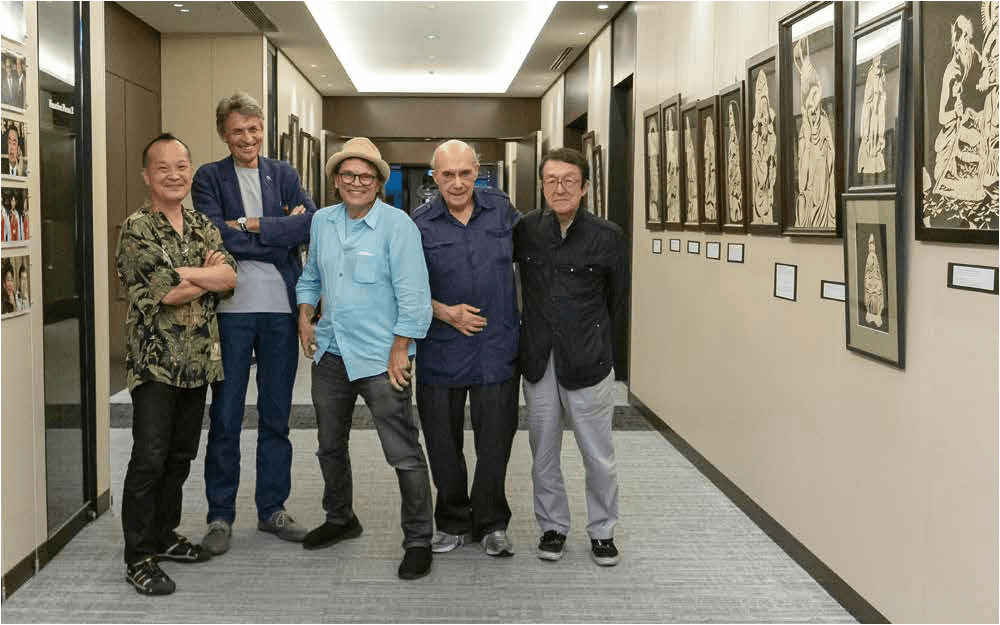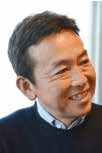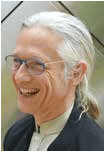Issue:

The Committee at the Club (beside the papercutting exhibition of Katsuyuki Yagi in August): Katsura Endo, Gavin Frew, Bruce Osborn, Robert Kirschenbaum and Katsuyoshi Ozaki, Absent on the day of the shoot were members Yoichi Yabe and Everett Kennedy Brown, above
Putting on a show
The Club’s Exhibition committee members are responsible for making the hallways a location for timely, eye catching images that cover a wide range of subjects
By Julian Ryall
Bruce Osborn has overseen no fewer than 106 displays of eye catching photographs and images for the FCCJ’s Exhibitions Committee but the 107th showcase, he says, was arguably the most difficult he has ever put together. “It is always a lot more than simply putting pictures on a wall,” he said. “Some of our monthly exhibitions are easier to prepare and others are harder, but this one was a major job. But it was also a labor of love.”
The exhibition, which opened on July 6 and was followed two days later by the now traditional reception, was an extension of 68 year old Osborn’s “Oyako” project, in which he has for many years been taking photographs of parents with their children. The exhibition featured 25 images, ranging from the amusing to the poignant to the sad to the simply beautiful.
Photographer Natsuki Yasuda’s image was of a young wom an who survived the March 2011 disaster that struck Japan’s Tohoku region as a schoolgirl, but is now a mother and has big dreams for her newborn daughter. Shisei Kuwabara contributed an iconic shot of a father holding his daughter, a severely disabled victim of Minamata Disease. Myanmarese photographer Zaw Min’s shot was a simple image of a woman from the Kayan people famed for the coiled necklaces that give them elongated necksas she breastfeeds her child.


IKUO NAKAMURA, A RENOWNED under water photographer, took the theme in an interesting direction by showing a black and white image of a whale with her young calf. And Osborn’s contribution was another monochrome image, depicting a young girl facing the camera and with her arms locked with her parents either side. She was wearing a simple dress but her parents, who are facing away from the camera, were covered head to toe in intricately drawn traditional Japanese tattoos.
“We had never attempted an event with this many photographers before so coordinating everything has been difficult at times,” he said. The 120 people who attended the opening night meant it was also the biggest reception the committee had ever hosted at the Club.
Osborn, who is originally from Los Angeles and moved to Japan in 1980, first agreed to join the committee after previous chair Tony McNicol stood down. He says the FCCJ’s wall space is much in demand. “There is no shortage of artists who want to do shows here, which is great. But with only 12 exhibitions a year it means I have to tell a lot of people that we are not able to schedule their show,” he said.
“With its selection of what to show, the committee wants to give priority to people who are working in the media photographers, artists, designers and offer a chance to share their work. It’s important that it is seen by as many people as possible. That is what we want our walls to be used for.
“I HAVE TO SAY that the Club’s new premises are a huge improvement on the old building for displaying these images,” Osborn said. “Before, the exhibitions were held in the bar area and it was difficult to see as customers were seated at tables in front of where the works were hung. Now we have the whole of that long hallway and a much improved space to view the pictures.
“Every time I walk down that hall and I see people stopping and looking at images, I say to myself ‘great’,” he added.
In addition to Osborn, the Exhibitions Committee has six members Katsura Endo serves as deputy chair and the rest of the team is made up of Robert Kirschenbaum, Everett Kennedy Brown, Katsuyoshi Ozaki, Yoichi Yabe and Gavin Frew. It tends to use the monthly receptions as an opportunity to introduce artists and share new information. With all of the committee members busy working, much of their preparatory work is done over email or the phone.
As well as giving creators a space in which to display their work, the committee tries to be timely and in sync with the news. In March 2011, Taishi Hirokawa had been preparing an exhibition for the following month, but he was able to quickly change direction and instead showed a series of images taken a few years previously of all 52 nuclear power plants operating across Japan, including the now infamous Fukushima Daiichi plant.
SINCE 2011, THE EXHIBITIONS held in the month of March have generally taken as their theme events related to the worst natural disaster to strike Japan in living memory. Members of the committee have traveled to Tohoku on a number of occasions in the intervening years to further document the lives of people who survived the disaster. Osborn himself has given workshops at local junior high and high schools.
The Club also stepped in when Korean photographer Ahn Sehong was told by the Nikon Salon exhibition space in Shinjuku in 2012 that it was cancelling his show of images featuring “comfort women” from the years of Japan’s colonial control of the Korean Peninsula.
“It was in the news a lot at the time and the right wing was being very vocal against it,” Osborn said. “I was concerned about not causing problems for the Club or the people working here but we discussed it and agreed that this was exactly the sort of thing that we should be showing at the press club. We had to do it.
” Another memorable exhibition featured the photographs of Liu Xia, a painter, photographer and poet who was under house arrest in China. Her husband, Liu Xiaobo, the world renowned Chinese dissident and winner of the Nobel Peace Prize in 2010, was imprisoned in a labor camp at the time.
The committee generally has exhibitions lined up two or three months in advance. Osborn is very diplomatic about the one time when an event fell through less than a week before it was scheduled to open, resulting in a stressful rearrangement at the last minute. In order to avoid such crises, the committee generally has exhibitions lined up two or three months in advance. But it is all worthwhile, according to Osborn.
“There are a couple of really good reasons to be on the committee,” he said. “I have great chances to meet a lot of really interesting and talented people, and I like being able to make connections between Club Members and exhibitors. It’s also fun to collaborate as a group and to see the overlap with other committees and people.”
Julian Ryall is Japan correspondent for the Daily Telegraph.

